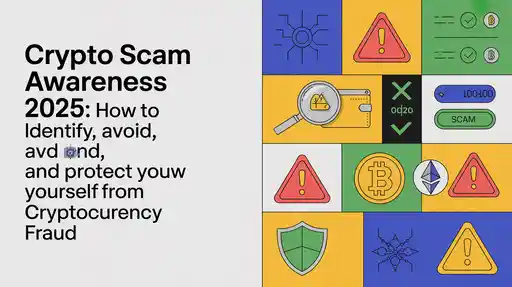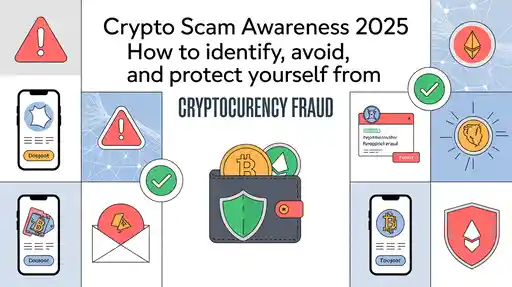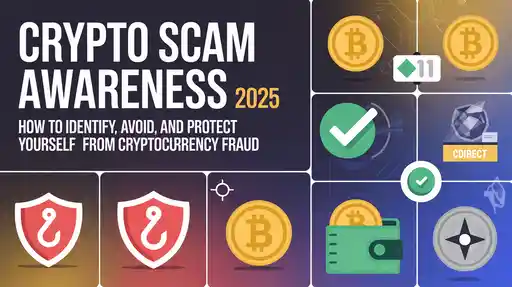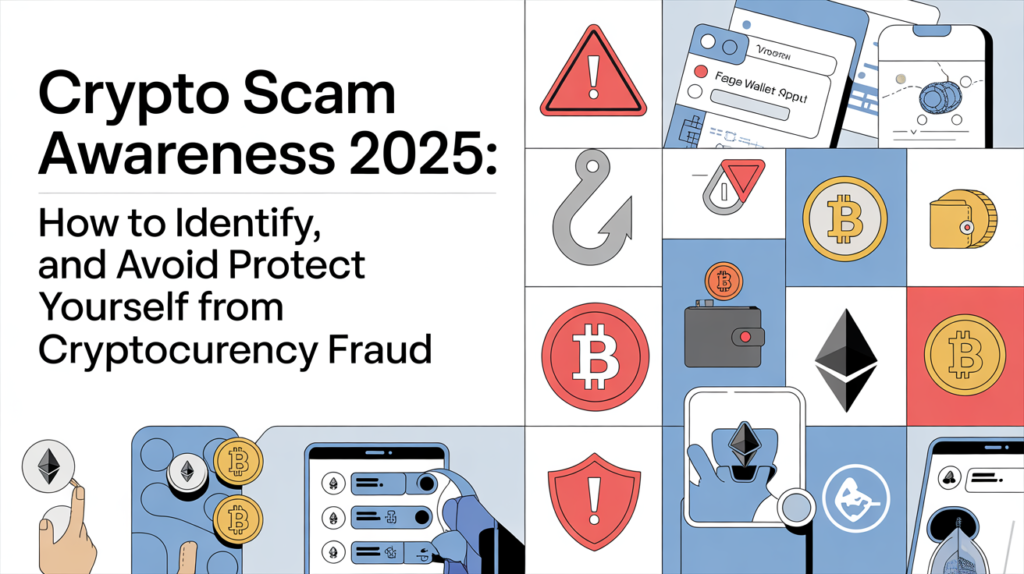Crypto Scam Awareness 2025: How to Identify, Avoid, and Protect Yourself from Cryptocurrency Fraud

Introduction: The Dark Side of Digital Gold
The world of cryptocurrency is a thrilling frontier — full of innovation, opportunity, and financial freedom. But where there’s gold, there are always bandits.
As crypto adoption surges globally, so too do the scams that threaten to undermine it. From fake exchanges and wallet drainers to phishing attacks and Ponzi schemes, scammers are evolving faster than ever.
In 2025 alone, crypto-related fraud has caused billions of dollars in losses worldwide, with the United States, India, and Southeast Asia among the hardest hit. What makes these scams so dangerous is that they’re not always obvious — they hide behind glossy websites, professional branding, and false promises of easy returns.
This article serves as your comprehensive guide to crypto scam awareness — helping you recognize red flags, understand how scams work, and take action before it’s too late.
Chapter 1: Why Crypto Scams Are Rising in 2025
1.1 The Boom that Invites the Bait
Cryptocurrency adoption has reached record highs. Millions of new investors are joining daily, many lured by headlines of overnight millionaires. But most newcomers have one thing in common: limited knowledge of blockchain technology.
Scammers thrive in that knowledge gap. They exploit excitement, fear, and greed — the three emotional triggers that cloud judgment.
1.2 The Perfect Storm: Hype Meets Anonymity
Unlike traditional finance, crypto operates in decentralized, pseudonymous ecosystems. That means no central authority to freeze accounts or reverse fraudulent transfers. Once funds are gone — they’re gone forever.
And scammers love that finality. They’ve built entire networks designed to mimic legitimate projects, exchanges, and influencers, deceiving even experienced users.
1.3 The Numbers Behind the Chaos
According to Chainalysis’ 2025 Crypto Crime Report:
-
Over $7.8 billion was lost to crypto scams in 2024, with projections topping $10 billion in 2025.
-
Romance scams and investment frauds now account for more than 50% of all crypto-related crime.
-
Rug pulls (fake crypto projects that disappear overnight) remain one of the top scam types in DeFi.
Chapter 2: The Psychology Behind Crypto Scams
2.1 Greed and FOMO (Fear of Missing Out)
The number one tool of crypto scammers isn’t technology — it’s psychology. They know how to trigger emotions that override logic.
When users see headlines like “Double your Bitcoin in 24 hours” or “Join before it’s too late,” FOMO kicks in.
Even seasoned investors can get swept up in the frenzy. Scammers understand that crypto moves fast — and they exploit the urgency.
2.2 Trust by Association
Fraudsters often impersonate trusted brands, exchanges, or influencers. Fake Elon Musk Twitter giveaways, counterfeit Binance websites, and cloned Telegram groups are classic examples.
Humans are wired to trust authority — and scammers weaponize that trust.
2.3 The Illusion of Legitimacy
Modern scams don’t look shady — they look professional.
Polished websites, slick marketing, even fake audits and customer reviews make them appear credible. The illusion of legitimacy is their strongest weapon.
Chapter 3: Common Types of Crypto Scams in 2025

3.1 Phishing and Wallet Drainers
Phishing scams are the oldest trick in the book — and still the most effective.
Users receive emails or messages that mimic legitimate crypto services, asking them to log in, verify, or connect their wallet.
The moment they enter credentials or approve a transaction — their funds vanish.
Example:
A fake “MetaMask security update” prompts users to re-enter their seed phrase. Within minutes, their entire balance is drained.
💡 Pro Tip: Never share your seed phrase or private keys. No legitimate platform will ever ask for them.
3.2 Rug Pulls and Fake Projects
Rug pulls are crypto’s version of an exit scam. Developers launch flashy tokens or DeFi platforms promising huge returns. Once enough money flows in, they pull the plug and disappear.
In 2025, DeFi rug pulls like FrostedSwap and ZenoFarm scammed investors of millions — despite audits and influencer endorsements.
💡 Warning Signs:
-
Anonymous team
-
Unrealistic APYs (anything over 200% annually)
-
No long-term roadmap or whitepaper
-
Liquidity not locked
3.3 Ponzi and MLM “Investment” Schemes
These scams promise consistent, guaranteed profits through “AI trading,” “staking bots,” or “crypto mining platforms.”
In reality, they’re classic Ponzi schemes, paying early investors with new deposits.
Once new money stops flowing, the system collapses.
Example:
“BitXMine” claimed to offer 10% daily returns. It ran ads across YouTube, Telegram, and TikTok — then vanished with over $200 million in user deposits.
💡 Rule of Thumb: If it sounds too good to be true, it always is.
3.4 Romance and “Pig Butchering” Scams
These scams mix emotional manipulation with financial deceit.
Scammers build relationships over weeks or months via dating apps, then slowly introduce crypto “investment opportunities.”
Victims, believing they’re helping a partner, end up transferring large sums to fake exchanges or wallets.
💔 Real Case:
A 38-year-old Californian woman lost $1.2 million after her online “boyfriend” convinced her to invest in a crypto trading app — which turned out to be a scam platform.
3.5 Fake Exchanges and Impersonation Scams
Scammers set up fake trading platforms or clone legitimate ones. These websites often look identical to real exchanges, complete with trading charts, live prices, and fake customer service.
Once users deposit funds, they’re unable to withdraw — the site simply disappears or blocks access.
💡 Tip: Always verify domain names (e.g., Binance.com vs. Binance.co-in.net). One extra hyphen can cost your life savings.
3.6 Giveaway and Airdrop Scams
Giveaway scams promise free crypto in exchange for a “small verification payment” or wallet connection.
Victims believe they’re participating in a real campaign — but their wallets are being drained by malicious smart contracts.
Legitimate airdrops never ask for money or private keys.
Chapter 4: How to Identify a Crypto Scam Before It’s Too Late
4.1 Check the Source
Always verify project legitimacy:
-
Official website (use HTTPS and verify certificate)
-
Social media handles with verified ticks
-
Team LinkedIn profiles and audits
4.2 Analyze Promises
If someone guarantees “daily profit,” “zero risk,” or “AI-powered trading,” it’s a red flag. Real crypto markets are volatile — no returns are ever guaranteed.
4.3 Look for Transparency
Legitimate crypto projects have:
-
Public GitHub code
-
Smart contract audits
-
Clear whitepapers
-
Real founders with public profiles
Anonymous teams and vague roadmaps are warning signs.
4.4 Research Reviews and Community
Search Reddit, Twitter, and Telegram discussions.
If a project silences criticism, deletes comments, or floods chat with bots — stay away.
Chapter 5: Real-World Scams That Shook the Crypto World

5.1 The BitConnect Collapse (Revisited)
BitConnect remains the most infamous crypto Ponzi scheme ever, costing investors over $3.4 billion. It promised 1% daily profits through “trading bots,” but was nothing more than a pyramid.
Its failure was a wake-up call — yet, countless clones continue to appear under new names each year.
5.2 FTX’s Legacy and Lessons
While not a scam in the traditional sense, the FTX collapse in 2022 showed how lack of transparency can destroy trust.
Billions were lost as users realized centralized platforms can fail — even “trusted” ones.
This incident pushed millions toward self-custody — a trend that continues in 2025.
5.3 OneCoin & Global Fraud
OneCoin, led by the now-fugitive “Crypto Queen” Ruja Ignatova, remains one of the largest financial scams in history — stealing $4.4 billion worldwide.
Her disappearance still symbolizes the risks of blind faith in charismatic founders.
Chapter 6: How to Protect Yourself and Your Crypto
6.1 Secure Your Wallets
-
Use hardware wallets (Ledger, Trezor) for long-term storage.
-
Never type your seed phrase online.
-
Enable multi-factor authentication (2FA) everywhere.
6.2 Verify Before You Trust
-
Always cross-check project URLs and team info.
-
Avoid sending crypto through DMs or random links.
-
Use reputable platforms like Binance, Coinbase, or Kraken.
6.3 Use Blockchain Explorers
Tools like Etherscan or BSCScan can show where your funds are going. If a wallet or contract looks suspicious — do not engage.
6.4 Revoke Suspicious Approvals
Regularly review and revoke dApp permissions using tools like Revoke.cash or Unrekt.net.
6.5 Stay Educated
Join legitimate crypto forums and follow trusted security researchers.
Knowledge is your best weapon in a decentralized world.
Chapter 7: What To Do If You’ve Been Scammed

7.1 Stay Calm and Document Everything
Take screenshots, transaction hashes, and chat records. This information will help investigations.
7.2 Report the Incident
-
In the U.S.: File a report with the FTC, FBI (IC3.gov), and your state’s cybercrime unit.
-
In India: Report via cybercrime.gov.in or your local police.
-
Globally: Contact the exchange where you sent funds — they may freeze addresses if alerted quickly.
7.3 Contact Blockchain Analytics Firms
Companies like Chainalysis, Elliptic, and TRM Labs specialize in tracing stolen crypto. While recovery isn’t guaranteed, timely action increases your odds.
Chapter 8: The Future of Crypto Security
8.1 Regulation Is Catching Up
In 2025, countries are introducing tougher regulations on KYC (Know Your Customer) and exchange accountability.
This is narrowing the gap scammers once exploited.
8.2 AI-Powered Fraud Detection
Machine learning tools can now detect suspicious on-chain activity, flagging scams before they spread.
8.3 Decentralized Identity (DID)
The next evolution of crypto security will be DID — digital passports that verify user identity without exposing personal data.
This could make anonymous scam accounts nearly impossible to operate.
Chapter 9: Awareness Is the Best Defense
The cryptocurrency industry thrives on innovation — but it also attracts deception.
Education and awareness are the strongest shields. By recognizing patterns, questioning promises, and staying informed, investors can enjoy the benefits of crypto safely.
Remember:
The blockchain never lies — but scammers do.
Stay alert. Stay skeptical. And above all — stay in control of your own keys.
Conclusion: The Price of Freedom Is Vigilance
Crypto represents financial freedom — but freedom comes with responsibility.
For every success story, there’s someone who fell for a scam that could have been avoided with awareness.
The solution isn’t to fear crypto — it’s to understand it.
With knowledge, discipline, and healthy skepticism, you can thrive in the digital economy while staying safe from those who exploit it.
So next time you see that “guaranteed return” or “free Bitcoin offer,” pause and ask:
Is this opportunity — or manipulation?
In crypto, awareness isn’t just power — it’s protection.